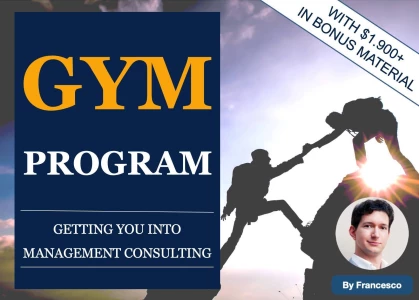Hi - I have a case study interview coming up, I will receive the case a couple of days in advance, but I have received a few details on it and I am expected to prepare a presentation - 2 slides - I will present for 20 minutes - any tips on how to approach this? I haven't done one in years! Topic will be cost reduction
M


Hi there,
Q: I will receive the case a couple of days in advance, but I have received a few details on it and I am expected to prepare a presentation - 2 slides - I will present for 20 minutes - any tips on how to approach this?
If I understood correctly, you will (i) first receive some material, (ii) then have to prepare a few slides on your own, (iii) the day of the interview you will have to present for 20 minutes.
I guess your main question is on how to prepare the slides (if you want to review general written case skills you can check this).
I would recommend to take into account the following.
- - - - - - - - - - - - - - - - - - - - - - - - - - - - - - - - - - - - - - - - - - - - - - - - - - - - - - - - - - - - - - - - - - - -
A) Structure of the presentation
Normally the structure for a 5-slide presentation is the following:
- 1st slide – summary of the questions and your answers
- 2nd, 3rd and 4th slides - supporting arguments for the first slide
- 5th slide - risks and next steps
In your case, you will have to compress in 2. It is a bit difficult to comment on how without knowing the questions and the prompt but you can probably cover similar areas.
B) Content of each slide
There are 3 basic components for most slides:
- Title
- Written content
- Graphs / Tables
Many candidates structure the title as a mere description of what the chart is about.
A great title instead shows the implication of the graph as well.
Example: say the graph is showing a cost structure for a division.
- A bad title would be: “Cost structure from 2005 to 2015”.
- A good title would be: “Cost structure of Division XYZ is not sustainable”.
- A great title would be “Cost structure of Division XYZ is not sustainable due to ABC”, assuming you have insights on that.
The rule of thumb is that if you read all the titles of the slides, you should get a clear idea of the message of the presentation.
C) Present the slides
When you present, I would recommend the following steps for each slide:
- Introduce the slide: “Let’s move to slide 2, which will show us why we have an issue with this division”
- Present the main message of the slide: “As you can see, we have a cost structure which makes it unfeasible to be competitive in this market”
- Provide details: “The graph, indeed, shows how our fix cost is XYZ, while competitors can benefit from economies of scale. Indeed…”
- - - - - - - - - - - - - - - - - - - - - - - - - - - - - - - - - - - - - - - - - - - - - - - - - - - - - - - - - - - - - - - - - - - -
If you want to prepare further, I do a session exactly on that.
Before the session, I can send you the data source to work on. We can then simulate the presentation during the class, reviewing step-by-step all the improvements needed.
Please feel free to PM me in case you have any questions.
Best,
Francesco

Hi there,
I would be happy to share my thoughts on it:
- First of all, I would highly advise you to seek the help of a coach if you haven't done any case studies in years.
- Moreover, I would advise you to prepare all aspects of the future assessment that you can, including solving case studies, basic knowledge about cost reduction, and the typical structure of consulting decks. This way, you will maximize your chances of being able to solve the assessment in a timely manner and with high quality.
If you would like a more detailed discussion on how to address your specific situation, please don't hesitate to contact me directly.
Best,
Hagen

Hi there,
If you haven't done one in years, haven't practiced, and are worried about this…hire a coach!
If a few hundred $ can be the difference between you getting the job and not getting it, would you spend that? Would you rather a few dinners out or the job?
Please invest in your success!
Now, in terms of how to do this. Here are the main tips:
- Practice beforehand (I have about 20 practice written cases…real ones from these companies). Get a practice one, work through it, then work on the next.
- Practice real casing - it's the same skillset
- Learn how to framework + interpret charts + graphs
- Get sample slides and revisit your powerpoint skills (I have 100+ slides templates)
- Finally, practice presenting
Good luck!

Hi,
Here are my thoughts:
1) In a way, this is slightly easier than a on-the-spot case interview, because you will have time to prepare in advance
2) Try familiarising with deliverables structure on cost reduction. Doing a google search will help. A full fledged deliverable would be something like this:
a) Problem Statement
b) Proposed Solution
c) Overall approach
d) Detailed Methodology
e) Implementation timeline
f) Next Steps
In your case, since it is just two slides, I think you should focus on A, B and F - this truly depends on the kind of question they give you though.
Hope this helps! Feel free to message me if you have any specific questions :)
Best,
Rushabh

Here's a great prior Q&A forum with plenty of tips- https://www.preplounge.com/en/consulting-forum/written-case-interview-prep-9412

Hi there,
That's a rather tight timeline.
Your options at this point are to:
1. Postpone the interviewer - unlikely to work since they already sent you the case prompt so they'll think you're just avoiding to answer it.
2. Give it your best shot - it could work, especially if you've currently working a job where you're regularly doing presentations, know how to communicate to executives, regularly structure conceptual problems.
3. Hire a coach - to help you accelerate through the process and be your thinking partner on that specific prompt.
Think about how much you want the job, what is the compensation that you'll be getting from it and then compare that with the coaching fee.
Best,
Cristian

This is one of those cases where you should hire a coach (one that gives you a customized session with a real case for that topic).
Overall what you need to train is top-down summarized communication.

Hi there,
great advice was given by the other coaches already. Would like to stress one more point - make sure you're top-down in the way you structure your presentation.
- Set context via intro (keep very brief)
- State the main conclusion / recommendation first
- Then add supporting points of (2) - back it up with data
- Add outlook: state clear next steps / key risks to consider to demonstrate forward thinking and action bias.
Hope this helps.
Cheers, Andi











